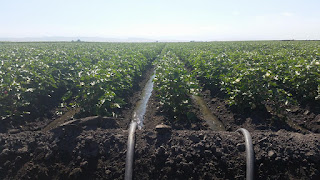It’s just nuts out there.
That’s
how field scout Jenna Mayfield describes the buzz of activity taking place in
almond orchards across the San Joaquin Valley. “Harvest is happening everywhere
– day and night,” Jenna points out.
Yes, tree shakers and orchard floor sweepers are
working around the clock to harvest the state’s No. 1 export crop.
 |
| Tree shaking occurring all day long. |
It’s safe to say there is a plenty of work to do –
like 890,000 acres worth of almonds in the state. For each tree, there’s an
estimated 5,829 nuts to shake off, according to the U.S. Department of
Agriculture’s National Agricultural Statistics Service (NASS). (Amazing how
they can come up with such a precise nut count.)
How far along each grower and each orchard are in
the harvest varies greatly. It varies by region in which climate and water
availability can play a role. “There’s some orchard blocks that are a month
away from harvest,” Jenna says.
The size of an almond operation can play a role in
the harvest timing as well.
Jenna
notes the farms with smaller acreage can get squeezed. Larger operations have
an advantage because of their sheer size. Contractors hired to shake trees and
sweep up the fallen nuts will make more money from the larger operations –
thereby giving them more priority.
 |
| A sweeper blows nuts into a pile for collecting off the ground. |
That can create problems for growers waiting a while
for a sweeper to arrive – even though the nuts may be ready to be collected and
hauled off to the processor. The longer the nuts sit on the ground, the greater
the potential for ant damage.
While growers can breathe easier once the harvest is
over, they still won’t have much time to take relax. There are plenty of
post-harvest chores ahead.
Jenna says one of the early tasks on the checklist
is inspecting the irrigation lines. This should be done even during mid-harvest
after the first time the shakers and sweepers go through the orchard.
 |
| Workers repair broken almond tree drip lines. |
The
harvesting machines can wreck havoc with irrigation lines as well as sprinkler
heads and emitters. “Drip lines can be spread all over the place. It’s fairly
commonly.” The result: Some areas of the orchard will be flooded while other
sections are left thirsty after growers turn on the water tap.
Jenna has first-hand experience. During one of her recent
scouting outings, Jenna spotted one section of orchard inundated with water
because of a busted line. She waded through the mud and muck to try to make
repairs, knowing the grower couldn’t afford to waste precious and costly water
supplies. Jenna eventually found crews to fix the line.
In the meantime, field scout Carlos Silva reports
alfalfa growers are irrigating their fields again, a good sign that the season
will extend into September. The drought sparked fears that the alfalfa season
would be cut short as growers divert their water supplies to other crops. A few
did that earlier this summer. But Carlos say most have persevered.
In
cotton, “everyone has pretty much wrapped up the last irrigation. All the
fields are starting to show open bolls,” Carlos says. Coming up will be defoliation and
then the fall harvest.
 |
| The cotton crop is getting the final irrigation of the season. |
On the pest front, aphid populations are still high
in the cotton fields while whitefly has remained in check. Growers need to keep
monitoring for these pest to avoid sticky cotton.
Meanwhile,
this month’s NASS crop production report estimated the California growers will
harvest 50,000 acres of upland cotton, yielding 1,728 pounds per acre. Pima
acreage is estimated at 109,000 acres with a yield put at 1,541 pounds per
acre.
 Field
Day Alert: Growers should check out the Almond Post
Harvest Management Field Day from 10
a.m. to 12:30 p.m. on Thursday, September 10, at the corner of Mercy
Springs Road and Cotton Gin Road in Los Banos. Pomologist David Doll of UCCE
Merced County will talk about fall and dormant cultural practices to reduce
disease and maximize next season’s tree productivity. UCCE IPM Advisor Dr.
Jhalendra Rijal will discuss seasonal considerations for pest monitoring in
almonds and Ganesh Vishwanath of SeaNutri will cover the use of seaweed-based
products in farming. Two continuingeducation credits areavailable as well as
CCA credits. For more information, contact Marcia Gibbs of the San Joaquin
Sustainable Farming Project at (530) 370-5325.
Field
Day Alert: Growers should check out the Almond Post
Harvest Management Field Day from 10
a.m. to 12:30 p.m. on Thursday, September 10, at the corner of Mercy
Springs Road and Cotton Gin Road in Los Banos. Pomologist David Doll of UCCE
Merced County will talk about fall and dormant cultural practices to reduce
disease and maximize next season’s tree productivity. UCCE IPM Advisor Dr.
Jhalendra Rijal will discuss seasonal considerations for pest monitoring in
almonds and Ganesh Vishwanath of SeaNutri will cover the use of seaweed-based
products in farming. Two continuingeducation credits areavailable as well as
CCA credits. For more information, contact Marcia Gibbs of the San Joaquin
Sustainable Farming Project at (530) 370-5325.









